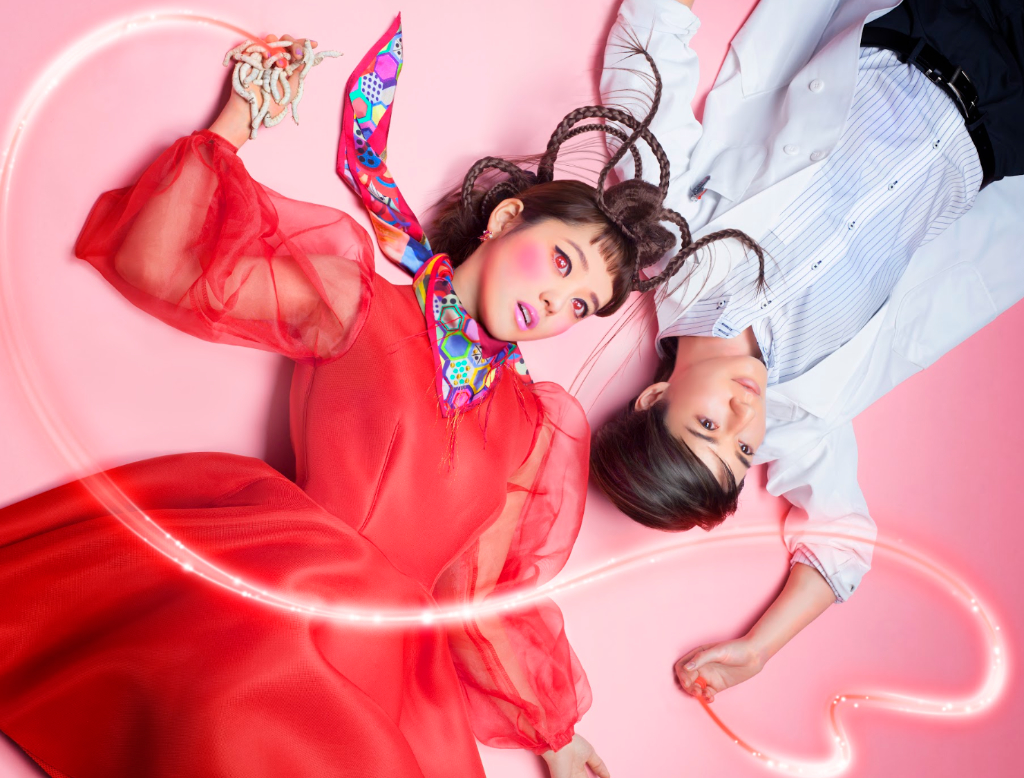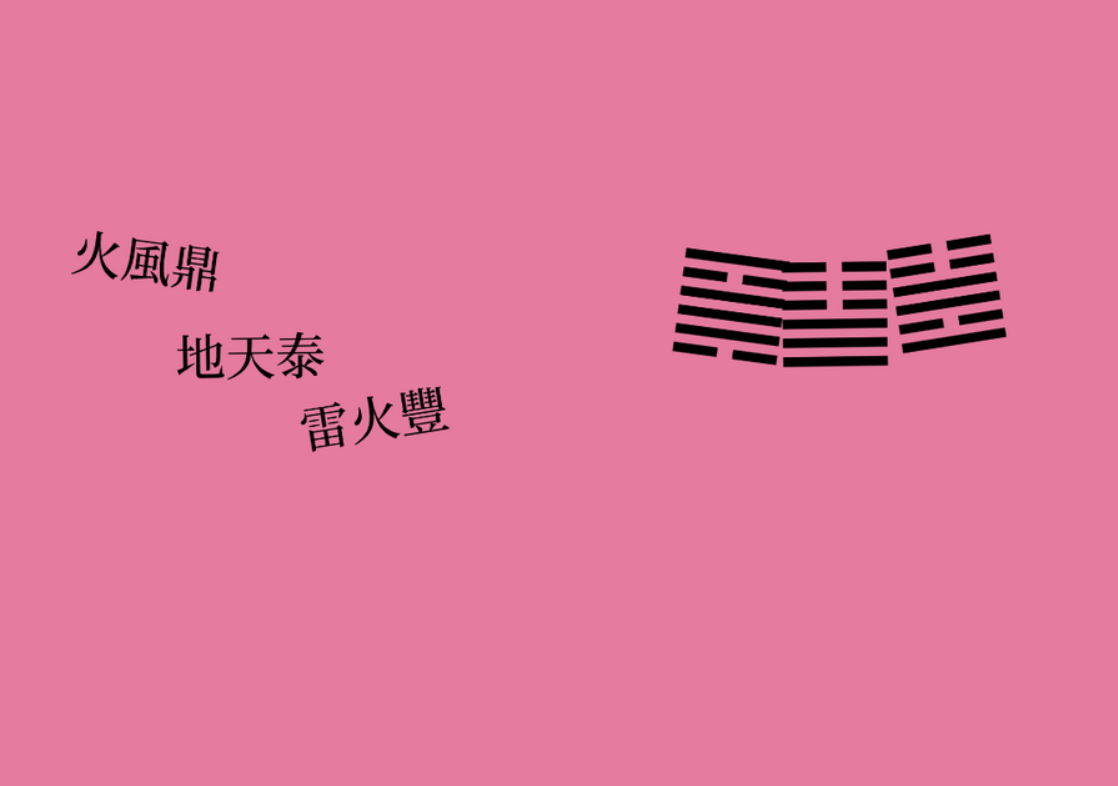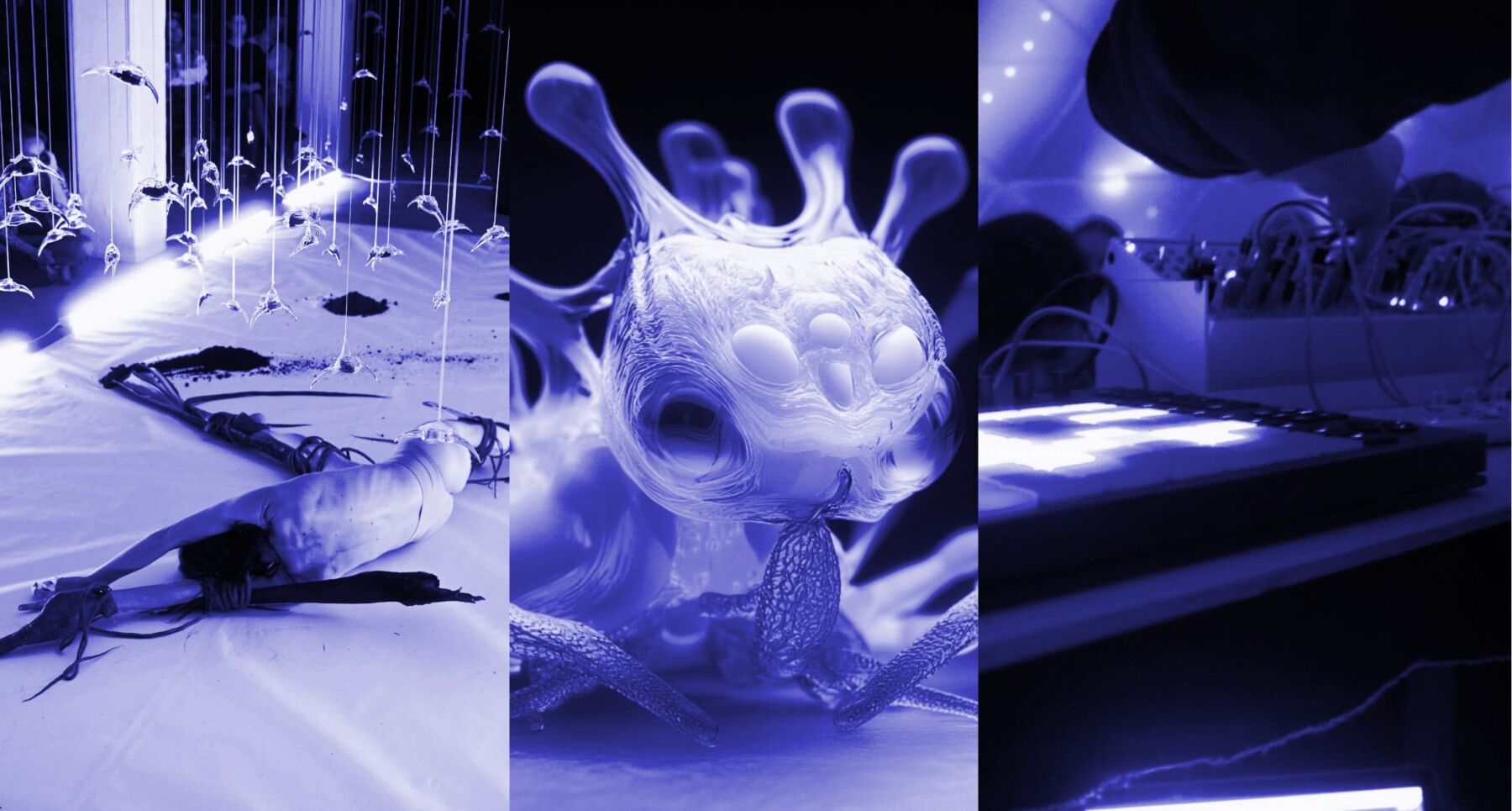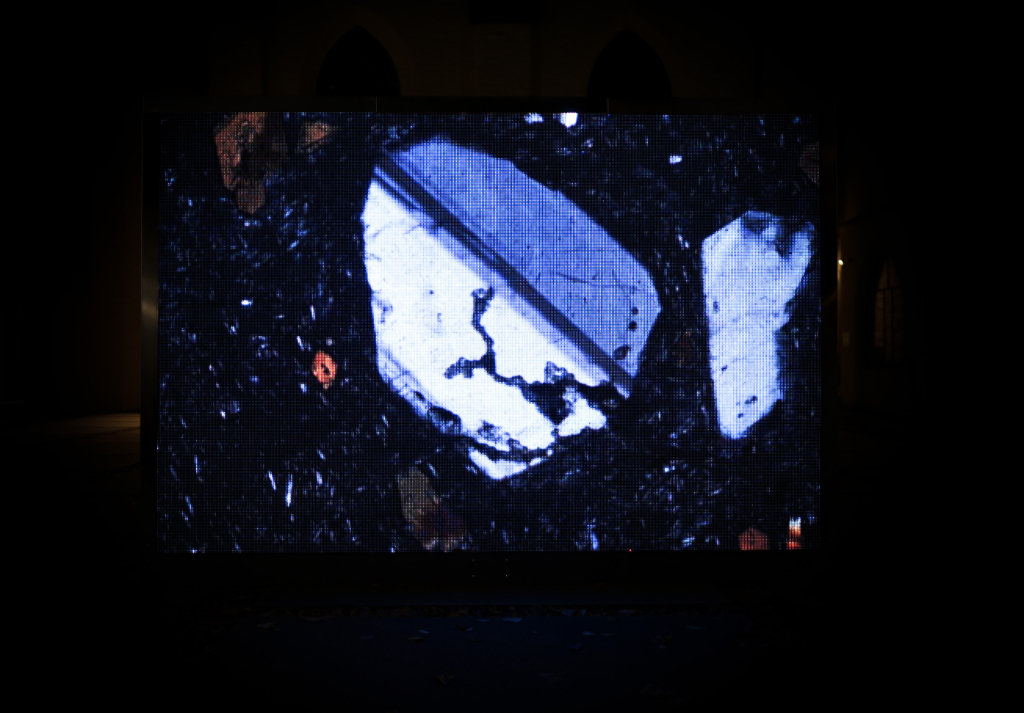Interview by Daniela Silva

Hiromi Marissa Ozaki, known as Sputniko!, is a British-Japanese artist, designer, and filmmaker whose work explores the intersections of technology, gender, and society. Growing up with a British mother and a Japanese father, both mathematicians, Sputniko! was drawn to logical reasoning and problem-solving from a young age. This interest led her to pursue a degree in Mathematics and Computer Science. However, as Sputniko! became more aware of technology’s social and cultural impact, she shifted her focus to the arts, earning a Master’s in Design Interactions from the Royal College of Art.
Sputniko! creates works that challenge societal norms and provoke discussion. One of her most recognised pieces, Menstruation Machine – Takashi’s Take (2010), is a wearable device that simulates menstruation, designed to spark conversations about gender and empathy. Sputniko!’s work often blends scientific research with cultural narratives. In Red Silk of Fate – The Shrine, she collaborated with Professor Hideki Sezutsu to bioengineer silkworms that produce silk infused with oxytocin, the “love hormone.” Inspired by East Asian mythology, which speaks of a red thread linking destined lovers, the project questions how biotechnology might alter traditional beliefs. Similarly, Moonwalk Machine – Selena’s Step critiques gender disparities in space exploration, presenting a young woman who builds a lunar rover with high-heeled shoes to symbolically leave her mark on the Moon.
Beyond her art, Sputniko! has played a role in academia and entrepreneurship. She was an Assistant Professor at the MIT Media Lab, leading the Design Fiction research group. She later joined the Tokyo University of the Arts as a professor in the Department of Design. Sputniko!’s interest in social impact also led her to establish Cradle, a women’s healthcare startup in Japan focused on improving corporate policies around menstrual health, pregnancy, and menopause. More recently, Sputniko! has expanded her focus to environmental issues. As a visiting artist at the Okinawa Institute of Science and Technology, she developed Coral Colors, a project using data visualisation to highlight the impact of climate change on coral reefs.
Through her interdisciplinary approach, Sputniko! continues to push boundaries, exploring how art and technology can challenge assumptions and shape future possibilities. Her work critiques societal structures and imagines new ways of understanding the world through creative and scientific collaboration.

Your work seamlessly blends art, technology, and social critique. How has your background in mathematics and computer science influenced your artistic journey?
I grew up in a family of mathematicians—both of my parents were professors in the field—so from an early age, I was immersed in a world of logical thinking and problem-solving. I spent my childhood experimenting with code and exploring abstract mathematical concepts.
At the same time, I was deeply excited by the transformative power of technology. I saw how it rapidly reshaped society, from AI to biotechnology, and I wanted to be part of that change. However, while studying mathematics and computer science at university, I became increasingly aware of the lack of diversity among those shaping the future of technology. This realisation sparked a sense of urgency in me—who gets to design technology, and whose perspectives are missing? These questions ultimately led me to create works like Menstruation Machine, which challenges the gender biases embedded in technology and society. My practice as an artist continues to explore these tensions, using critical narratives to provoke conversations about the future we are building.
As an artist working at the intersection of technology and feminism, what challenges have you faced in addressing gender disparities through your art?
Addressing gender disparities through art has always come with challenges, particularly the struggle to be understood. When I released Menstruation Machine in 2010, discussions around menstruation and women’s health were far more taboo than they are today. Even in progressive spaces, many were uncomfortable engaging with these topics. But times have changed.
Now, in 2025, menstruation and women’s health are widely discussed in the media, and Japanese corporations are rapidly adopting policies to support women’s health. Some companies have even begun hosting official menstrual pain experience workshops—something unimaginable a decade ago.
Collaboration is essential in your projects. Could you share insights into how you collaborate with scientists and other professionals to bring your concepts to life?
I am incredibly fortunate to collaborate with experts in biology, medicine, and engineering. My creative process often begins with a question, leading me to seek out scientists or specialists interested in working together. I frequently read research news, and when something captures my interest, I reach out directly to the researchers.
This is exactly how The Red Silk of Fate came to life. I discovered the research by Professor Hideki Sezutsu on genetically modified silkworms that produce fluorescent silk. Inspired, I asked him, “Could silkworms be engineered to produce silk infused with oxytocin, the ‘love hormone,’ to produce the mythical Red String of Fate?” He was intrigued, and within months, his lab successfully created the world’s first silkworms that spun red-glowing silk containing oxytocin.
I think the researchers enjoy the creative challenge of applying their work in unexpected ways. Communication is key as we invest time in understanding each other’s language and goals. Ultimately, working across disciplines has greatly expanded the scope of my art.
Menstruation Machine – Takashi’s Take is one of your notable works. What inspired you to create a device that simulates menstruation, and how has it been received across different cultures?
Menstruation Machine – Takashi’s Take was born from my personal questions and frustrations. As a teenager, I suffered from severe menstrual pain every month, and I remember thinking, “It’s the 21st century—why are women still enduring this? Why have science and technology not solved such a fundamental issue?” That thought, combined with my curiosity about what would happen if biological men could experience menstruation, led me to create a device that simulates the experience.
The Menstruation Machine is a wearable device that applies pain to the lower abdomen while releasing blood, replicating a typical five-day menstrual cycle. Alongside the device, I also created a music video that tells the story of a man named Takashi, who invents the machine to understand what his female friends go through. My goal was to challenge the fixed idea that menstruation is solely a “women’s issue” and provoke thought—how would society change if everyone could experience menstruation firsthand?
The response to this work was overwhelming, and its reception varied across different cultures. When I released the video online, it went viral almost instantly, sparking global discussions on the topic. Even in Japan, where menstruation is often considered a taboo subject, the project created opportunities for open public conversations about the experience.
Meanwhile, the Menstruation Machine was exhibited overseas at MoMA in NY and Pompidou-Metz in France, and M+ later acquired it in Hong Kong. It was fascinating to see that, despite cultural differences, people could relate to the work and engage in open discussions about menstruation. That, for me, was the most exciting part—watching a dialogue emerge where there had previously been silence.
In Red Silk of Fate – The Shrine, you combine genetic engineering with East Asian mythology. What message were you aiming to express by creating bioengineered silk containing the “love hormone” oxytocin?
In Red Silk of Fate – The Shrine, I wanted to weave together ancient mythology and cutting-edge biotechnology to question the nature of love and fate. According to legend, two destined lovers are connected by an invisible red thread. I wondered—what if we could use biotechnology to literally bring this myth to life?
By genetically engineering silk infused with oxytocin—the so-called “love hormone” that fosters emotional bonding—I sought to explore a provocative question: If we can artificially create the chemistry of love, what happens to our perception of fate? I wanted people to consider what technology means when it intervenes in our most cherished beliefs and intimate experiences. At the same time, I was also interested in exploring the dialogue between modern science and traditional spirituality.
After successfully developing silkworms that produced red-glowing, oxytocin-infused silk, I took the material to a Shinto shrine and spoke with a priest about its significance. I learned that in Shinto belief, even artificially created life is considered to have a spirit, which I found very thought-provoking.
In the installation, I used the engineered silk to create a shrine-like structure, symbolically enshrining the bioengineered silk. The work invites viewers to consider: When science turns legend into reality, how does that change our understanding of love and fate? This piece is an invitation to reflect on the evolving boundaries between mythology and scientific advancement.
Tranceflora features garments made from genetically modified glowing silk. How do you see the fusion of traditional craftsmanship with advanced biotechnology influencing the future of fashion?
In Tranceflora, where we created Kimono-inspired dresses from genetically modified glowing silk, I was deeply excited by the interaction between traditional craftsmanship and cutting-edge biotechnology. It was a rare opportunity to see centuries-old silk-weaving techniques collaborating with biotechnology. This fusion of the old and the new offers a glimpse into the future of fashion, showing that textiles can evolve beyond conventional materials and incorporate bio-designed elements.
Moonwalk Machine – Selena’s Step portrays a young woman aspiring to leave her footprint on the moon. How does this piece reflect your views on gender roles in science and space exploration?
Moonwalk Machine – Selena’s Step explores gender disparities in science and space exploration. I was struck by the fact that decades after Neil Armstrong’s first step, only twelve people had walked on the Moon—all white men. That realisation led me to imagine a young woman challenging this imbalance.
The piece follows Selena, a teenager who builds a lunar rover equipped with high-heeled shoes and leaves a trail of footprints on the Moon. While playful in execution, the work makes a serious statement: femininity and scientific ambition are not mutually exclusive.
By inserting a woman’s presence into the traditionally male-dominated narrative of space exploration, Moonwalk Machine questions why it has taken so long to consider a female footprint on the Moon. If it sparks the imagination of young women and encourages them to see themselves in science, then the work has done its job.
With the rise of NFTs and digital art platforms, how do you view the evolution of art consumption and the opportunities these technologies present for artists?
The rise of NFTs and digital art platforms has undeniably transformed how art is consumed, distributed, and valued. On one hand, these technologies have democratised access, allowing artists to reach global audiences without relying on traditional gatekeepers like galleries or auction houses.
They have also introduced new economic models, enabling direct sales and royalties through the use of smart contracts. However, I remain critical of the NFT ecosystem. While initially intrigued by its decentralised potential, I question whether it fosters cultural value or prioritises speculative investment over artistic integrity. Much of the NFT market has been driven by hype rather than long-term artistic contribution. That said, blockchain technology still holds promise for artists, particularly in terms of digital ownership and the development of new, generative art forms. The challenge is to ensure that these tools serve artists meaningfully, rather than simply reinforcing financial speculation.
As the founder of Cradle, a women’s healthcare startup, how do you balance your entrepreneurial ventures with your artistic practice, and in what ways do they influence each other?
I don’t see my entrepreneurship and art as separate—they both stem from a desire to challenge norms and create impact. Cradle, my women’s healthcare startup, extends my artistic practice. As my art sparks conversations around gender and technology, Cradle pushes for systemic change in corporate health policies.
When designing Cradle’s initiatives, I apply the same conceptual thinking and storytelling techniques to my art. For example, making women’s health a corporate priority requires shifting perspectives—like creating artwork that challenges societal norms. At the same time, my work at Cradle informs my art, providing real-world insights that inspire new projects.
Balancing both roles hasn’t been difficult. Early on, some saw my move into entrepreneurship as a departure from art—perhaps they thought I had quit! But as Cradle grew—now serving over 70 companies and preparing for an IPO—it became clear that this, too, is a form of social sculpture. Whether through an artwork or a company, my goal remains the same: to reshape society through creativity.
What’s your chief enemy of creativity?
Long Working Hours.
You couldn’t live without…
Travel!





